Four Steps to Becoming an E-learning Pro
UMBC’s ISD Now! Webinar Series is holding its next webinar on Wednesday, April 13, 2011 from 2 to 3 p.m. EST. Guest speaker, Tom Kuhlmann, VP of Articulate, will discuss Four Steps to Becoming an E-Learning Pro.
Join us and learn to:
• Design an e-learning strategy based around available resources
• Get the most out of simple, practical e-learning projects
• Visually align course designs around learning objectives and content
• Apply rapid instructional design models to make courses more engaging and interactive
This webinar is free and open to the public.
It is a rare chance.









